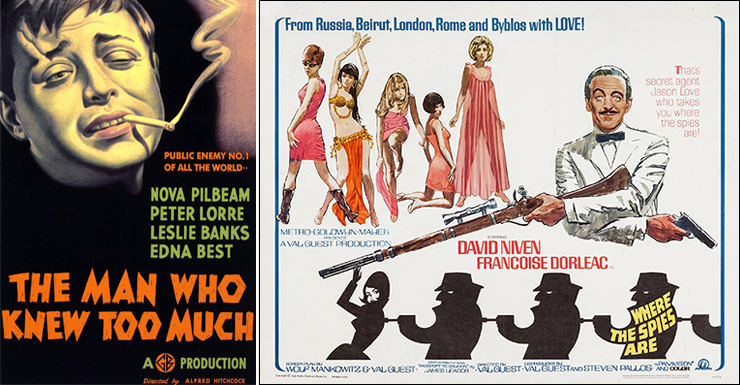|
In 2021, the biggest sin
perpetrated by the 25th Bond film, No Time To Die, was that it
wasted one of Ian Fleming’s finest ideas, ‘The Garden of Death’, from his
penultimate novel, YOU ONLY LIVE TWICE, and used it as little more than a
footnote in the film’s screenplay; the last unused plot point in the
entire Bond canon was merely crammed into the narrative because, of
course, they had to include the obligatory Fleming reference. See? We
still go back to Fleming! Other than that, the legal credit Ian Fleming’s
James Bond 007 had never felt so hollow. |
 |
|
Which brings me to the
problem with this - Anthony Horowitz’s third (and allegedly final) Bond
novel: instead of standing on its own two feet, it recycles Fleming’s
ideas instead of continuing them. Horowitz acknowledges “Robert Markham”
merely as another writer who had a try at continuing directly after
Fleming, but what makes Markham’s (Kingsley Amis’) COLONEL SUN unique is
that “Markham” was the only writer who had the privilege of writing
immediately after Fleming’s death - the novel being written within roughly
the same historical period in which the story is set. |
 |
|
WITH A MIND TO KILL is by
no means the first period continuation Bond novel. Starting with the
surprisingly good YOUNG BOND novels by Charlie Higson, Ian Fleming
Publications has mostly tried to set themselves apart from the movie
version of James Bond by commissioning Bond novels set during the cold war
– this, only after having allowed an American with no fiction writing
credentials to indulge in what can only be described as third-rate fan
fiction. It is not even the first novel to rewrite the events after THE
MAN WITH THE GOLDEN GUN. In 2008, Sebastian Faulks gave us DEVIL MAY CARE,
which ignored the events of COLONEL SUN altogether and was set some 18
months after we left Bond at the end of Fleming’s final novel. Fleming was
not precisely what you’d call the strictest chronologist, but his novels
can be read in the same order they were published without much trouble,
whereas this latest novel can only be accepted if we ignore Markham’s 1968
entry. I’m not a fan of alternate universes in literary sagas. Surely
there’s an entire decade (the 70s) in which not a single Bond novel is
set. Do we have instead to have three novels set in the same timeline only
so they can claim to be following Fleming’s footsteps? |
 |
|
WITH A MIND TO KILL aims
at exploiting the early elements of THE MAN WITH THE GOLDEN GUN. That
novel is unique in that its beginning promises a much more interesting
story than the one we end up with. Obviously inspired by the success of
dirtier novels such as Le Carré’s and Deighton’s, Fleming got into true
cold war material that screamed for further development, only to be let
down by his failing health into delivering a recycled GOLDFINGER. Horowitz
begins from this juncture by taking off from Bond’s attempt to assassinate
his boss, M. The problem is, that as Fleming did not develop that
storyline further, we’re expected to believe that the plot to fool the
Soviets in Horowitz’s novel occurs only after Bond has returned
from his Jamaican assignment. It’s the problem of writing by committee:
you can ignore COLONEL SUN and DEVIL MAY CARE, but you can’t ignore any of
Fleming’s novels because they are canon. WITH A MIND TO KILL would have
been a much finer novel if it had followed directly after the attempted
assassination and de-brainwashing, even if that had meant ignoring the
events surrounding Francisco Scaramanga. That way, Horowitz would have had
more freedom to manipulate the material. As it happens, the outcome is
somewhat predictable: M’s assassination is faked for the Russians to
recruit Bond. It could have been more radical, with Bond indeed escaping
after the botched attempt, with MI6 hot on his heels. The way it is
presented by Horowitz it is too safe. The tension doesn’t start until Bond
is abducted by the Russians and, unfortunately, that eats a lot of the
page count. |
 |
|
This essentially reduces
the story development to Bond waiting for the villains to reveal their
scheme - and here’s my biggest complaint about WITH A MIND TO KILL: it’s
so clearly a rehash of The Man Who Knew Too Much (1934). Sebastian
Faulks’ novel was criticized for its similarity to an obscure spy movie
(and novel), Where The Spies Are (1966), which currently will only have
been seen by film obsessives who haunt TCM and other such channels, but
Hitchcock’s film (especially the 1956 remake) is obligatory watching even
for casual movie and spy buffs). I won’t go into details in case you
happen not to have seen the original, let’s suffice to say that I saw it
coming in the novel before it was revealed - which is a pity, because the
novel is well written, and Horowitz does know Fleming’s Bond better than
any other writer I can think of. One chapter, while Bond is under Russian
care before the big reveal, portrays the character exactly as Fleming
would have. His dialogue, his attitude, is all genuine. Horowitz gave us
one truly memorable Bond novel the first time around with TRIGGER MORTIS,
that followed on directly after GOLDFINGER, and still managed to be its
own thing, but his latest effort is disappointing in that it could have
been so much more, it could have opened the possibility for a series of
direct continuations, maybe a trilogy. As it stands, it is fun and
disposable (and very short) and aimed only at very forgiving, loyal fans. |
 |
|
ABOVE: A CURIOUS
BOND! (left) Slovakian born actor Peter
Lorre (1904-1964) whose first English speaking role was in
Alfred Hitchcock's classic thriller The Man Who Knew Too Much
(1934). Lorre would later play Le Chiffre in the 1954 live US
television version of Casino Royale opposite
Barry Nelson
as James Bond. (right) Where The Spies Are (1966) was a
British comedy-adventure film starring
David Niven
as Doctor Jason Love based on the 1964 James Leasor novel
Passport to Oblivion. Niven would play Sir James Bond in the
1967 spoof film version of Casino Royale. Where The
Spies Are was directed by
Val Guest
who also directed David Niven in his segments of Casino Royale
(1967). The screenplay of Where The Spies Are was
co-written by Val Guest and
Wolf
Mankowitz, who was also the primary screenwriter of Casino
Royale (1967), and had earlier been one of the screenwriters
on the first James Bond film Dr. No (1962) although he did
not want to take a credit for his contribution. Mankowitz was
also the man who had introduced producers
Harry
Saltzman & Albert R. Broccoli in 1961.
In 2020 James Leasor's Passport To Oblivion was produced as an
audiobook
with one-time James Bond
George
Lazenby playing Dr. Jason Love. |
|
|
|
Donovan Mayne-Nicholls
was born in 1971. He graduated as a bachelor in English language from the
Pontifical Catholic University, Chile, with a thesis analysing the short
stories of Ian Fleming. He occasionally writes about movies for local
online publications. |



